西南科技大学3001材料科学导论2019年考博真题
- 格式:pdf
- 大小:1.38 MB
- 文档页数:3
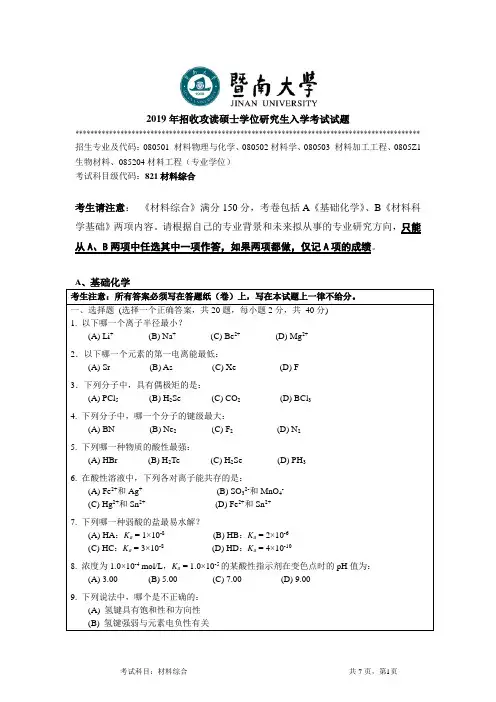
2019年招收攻读硕士学位研究生入学考试试题******************************************************************************************** 招生专业及代码:080501 材料物理与化学、080502材料学、080503 材料加工工程、0805Z1 生物材料、085204材料工程(专业学位)考试科目级代码:821材料综合考生请注意:《材料综合》满分150分,考卷包括A《基础化学》、B《材料科学基础》两项内容。
请根据自己的专业背景和未来拟从事的专业研究方向,只能从A、B两项中任选其中一项作答,如果两项都做,仅记A项的成绩。
A、基础化学考生注意:所有答案必须写在答题纸(卷)上,写在本试题上一律不给分。
一、选择题(选择一个正确答案,共20题,每小题2分,共40分)1. 以下哪一个离子半径最小?(A) Li+(B) Na+(C) Be2+(D) Mg2+2.以下哪一个元素的第一电离能最低:(A) Sr (B) As (C) Xe (D) F3.下列分子中,具有偶极矩的是:(A) PCl5(B) H2Se (C) CO2(D) BCl34. 下列分子中,哪一个分子的键级最大:(A) BN (B) Ne2(C) F2(D) N25. 下列哪一种物质的酸性最强:(A) HBr (B) H2Te (C) H2Se (D) PH36. 在酸性溶液中,下列各对离子能共存的是:(A) Fe2+和Ag+(B) SO32-和MnO4-(C) Hg2+和Sn2+(D) Fe2+和Sn2+7. 下列哪一种弱酸的盐最易水解?(A) HA:K a= 1×10-8(B) HB:K a= 2×10-6(C) HC:K a= 3×10-8(D) HD:K a= 4×10-108. 浓度为1.0×10-4 mol/L,K a = 1.0×10-5的某酸性指示剂在变色点时的pH值为:(A) 3.00 (B) 5.00 (C) 7.00 (D) 9.009. 下列说法中,哪个是不正确的:(A) 氢键具有饱和性和方向性(B) 氢键强弱与元素电负性有关四.综合题(共1小题,共25分)请根据下图所示的二元共晶相图分析和解答以下问题(1)分析合金Ⅰ、Ⅱ的平衡结晶过程,并绘制冷却曲线。
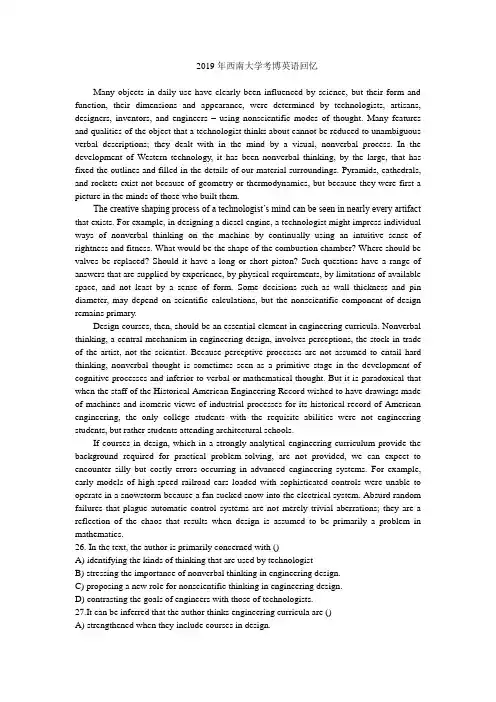
2019年西南大学考博英语回忆Many objects in daily use have clearly been influenced by science, but their form and function, their dimensions and appearance, were determined by technologists, artisans, designers, inventors, and engineers –using nonscientific modes of thought. Many features and qualities of the object that a technologist thinks about cannot be reduced to unambiguous verbal descriptions; they dealt with in the mind by a visual, nonverbal process. In the development of Western technology, it has been nonverbal thinking, by the large, that has fixed the outlines and filled in the details of our material surroundings. Pyramids, cathedrals, and rockets exist not because of geometry or thermodynamics, but because they were first a picture in the minds of those who built them.The creative shaping process of a technologist’s mind can be seen in nearly every artifact that exists. For example, in designing a diesel engine, a technologist might impress individual ways of nonverbal thinking on the machine by continually using an intuitive sense of rightness and fitness. What would be the shape of the combustion chamber? Where should be valves be replaced? Should it have a long or short piston? Such questions have a range of answers that are supplied by experience, by physical requirements, by limitations of available space, and not least by a sense of form. Some decisions such as wall thickness and pin diameter, may depend on scientific calculations, but the nonscientific component of design remains primary.Design courses, then, should be an essential element in engineering curricula. Nonverbal thinking, a central mechanism in engineering design, involves perceptions, the stock-in-trade of the artist, not the scientist. Because perceptive processes are not assumed to entail hard thinking, nonverbal thought is sometimes seen as a primitive stage in the development of cognitive processes and inferior to verbal or mathematical thought. But it is paradoxical that when the staff of the Historical American Engineering Record wished to have drawings made of machines and isomeric views of industrial processes for its historical record of American engineering, the only college students with the requisite abilities were not engineering students, but rather students attending architectural schools.If courses in design, which in a strongly analytical engineering curriculum provide the background required for practical problem-solving, are not provided, we can expect to encounter silly but costly errors occurring in advanced engineering systems. For example, early models of high-speed railroad cars loaded with sophisticated controls were unable to operate in a snowstorm because a fan sucked snow into the electrical system. Absurd random failures that plague automatic control systems are not merely trivial aberrations; they are a reflection of the chaos that results when design is assumed to be primarily a problem in mathematics.26. In the text, the author is primarily concerned with ()A) identifying the kinds of thinking that are used by technologistB) stressing the importance of nonverbal thinking in engineering design.C) proposing a new role for nonscientific thinking in engineering design.D) contrasting the goals of engineers with those of technologists.27.It can be inferred that the author thinks engineering curricula are ()A) strengthened when they include courses in design.B) weakened by the substitution of physical science courses for courses designed to develop mathematical skills.C)strong because nonverbal thinking is still emphasize by most of the courses.D)strong despite the errors that graduates of such curricula have made in the development of automatic control system.28.which of the following statements best illustrates the main point of the first two paragraphs of the text?()A) When a machine like a rotary engine malfunctions, it is the technologist who is best equipped to repair it.B) Each component of an automobile – for example, the engine or the fuel tank – has a shape that has been scientifically determi ned to be best suited to that component’s function.C) A telephone is a complex instrument designed by technologists using only nonverbal thought.D) The distinctive features of a suspension bridge reflect its designer’s conceptualization as well as the physical requirements of its site.29.Which of the following statements would best serve as an introduction to the text?()A) The assumption that the knowledge incorporated in technological developments must be derived from science ignore the many nonscientific decisions made by technologists.B) Analytical thought is no longer a vital component in the success of technological development.C) As knowledge of technology has increased, the tendency has been to lose sight of the important role played by scientific thought in making decisions about form, arrangement, and texture.D)A movement in engineering colleges toward a technician’s degree reflects a demand for graduates who have the nonverbal reasoning ability that was once common among engineers.30.The author calls the predicament faced by the Historic American Engineering Record paradoxical (line 6, paragraph 3) most probably because ()A) the publication needed drawings that its own staff could makeB) architectural schools offered but did not require engineering design courses for their studentC) college students were qualified to make the drawings while practicing engineers were not.D) engineering students were not trained to make the type of drawings needed to record the development of their own disciplineThe remarkable progress of science and technology in the 20st century has brought enormous benefits to humankind. Long and healthy lives, economic prosperity and a pleasant and convenient living environment have resulted from technological progress based on advances in scientific knowledge. This progress will continue or may even accelerate in the future, because both the number of scientists and their activities are expanding throughout the world. We may expect, therefore, that science and technology will continue to contribute to the development of human society.At the same time, rapid scientific advances may raise some difficult problems. First of all, the disparity in scientific knowledge between those in scientific and technical professions andthose in other areas will continuously expand. This may create a communications gap between the two groups that could affect obtaining public consent on important issues, such as the use of genetically engineered plants or human embryonic stem cells. Secondly, the 21st century will be characterized by a knowledge-based society and a knowledge of science will be required for many professions. Those who lack scientific knowledge will have fewer opportunities for good jobs. Thirdly, the enormous increase in scientific information will become a burden for children who must study science. Already young people seem to be losing interest in science, and this trend may increase in the future. Over the past several years, enrollment in high-school physics courses in Japan has been decreasing, which suggests that many young people are losing interest in physics or avoiding subjects that require diligent study. Finally, scientific research in the next century will require increasing levels of public investment because sophisticated research is usually expensive. If the public loses interest in, science or does not understand the importance of research, it will become difficult for scientists to obtain sufficient financial support.Because of these considerations, I think that we need to carefully review present science education at different levels and to improve it in order to meet the expected rapid progress of science in the 21st century. At the level of primary education, the’most important task is to stimulate children’s interest in nature. Naive surprise at the wonders of nature will hopefully lead to a later interest in science. During their secondary education, students must learn logic and the principles of natural phenomena. They will gradually separate into groups of those who like and those who dislike science. It will be difficult to provide the latter students with the scientific basics that would be useful throughout their lives. This is also the case in university education.It is becoming a goal of general university education to give students who are not majoring in natural science and engineering some level of scientific literacy. In the future, all citizens, especially those expected to lead diverse areas of society should have a sound basis for understanding the progress of science. Because the pace of progress will accelerate further, continuing science education for the public is also of great importance.1.The first paragraph aims at _____A.Overstating the importance of science and technology.B.Highlighting the crucial role scientists play in the development of science and technology.C.Introducing the problems brought about by rapid scientific advances whiles stating theenormous benefits brought about by the progress of science and technology.D.Predicting the trend of the development of science and technology.2.According to the text, that young people seem to be losing interest in science_____.A.Causes the lack of scientists throughout the world in future.B.Is mainly due to the explosion of scientific information.C.Hinders the development of human society.D.Increases the communications gap between young people and scientists.3.The second paragraph is to denote_____A.The gap between scientific and technical professional and non-professionals.B.The difficulties faced by young people in finding jobs.C.The difficulties problems raised by rapid scientific advances.D.Scientific research in the 21th century.4.To which of the following statements is the author most unlikely to agree?A.It is a sheer waste of time and money to force those who dislike science to learn science.B.Stimulating children’s interest in nature is the top priority for primary and secondary schoolauthorities.C.Secondary school students should learn logic and the principles of natural phenomena.D. A knowledge of science will be required for many professional in the 21st century5.The best title for this text might be_____A.Science education for the publicB.Science and technology in the 21st centuryC.Scientific advance and ensuing problemsD.The goal of primary, second and higher education还有一篇阅读是讲迈克杰克逊的歌曲,专辑。
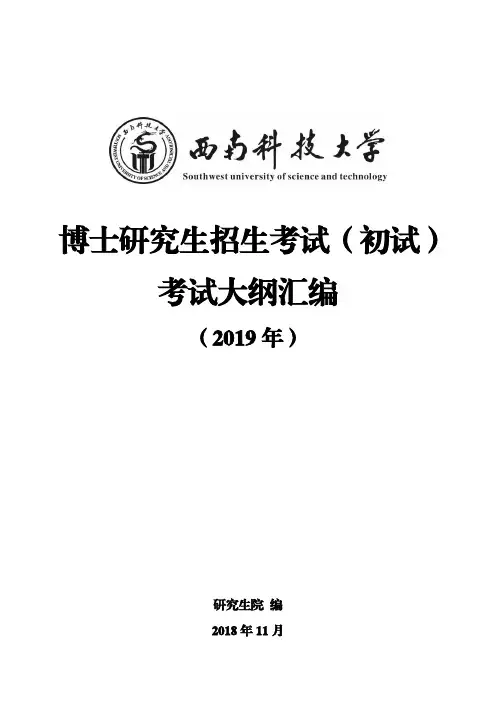
博士研究生招生考试(初试)考试大纲汇编(2019年)研究生院编2018年11月2001 物理化学一、总体要求物理化学是化学学科的理论基础,要求考生较系统地掌握化学热力学、化学动力学、电化学、界面化学和胶体化学的基本概念、基本理论、原理和方法及其应用,具有一般科学方法的训练和逻辑思维能力。
二、内容及比例1.热力学:30%左右热力学基本概念(系统、环境、广度性质、强度性质、热力学平衡态、状态函数、功、热、过程、途径、热力学能),体积功的计算,热力学第一定律、热容,焓,可逆过程,绝热可逆过程,Joule-Thomson效应,化学反应热效应,反应进度,物质的标准态及反应的标准摩尔焓变、Hess定律,标准摩尔生成焓,标准摩尔燃烧焓,化学变化Δr Um、ΔrHm、Q、W的计算,Kirchhoff定律,绝热反应。
热力学第二定律的表述,自发过程及其特征,Carnot循环及Carnot定理,Clausius不等式,熵增加原理,熵判据,熵的统计意义,热力学第三定律,ΔS 的计算,Helmholtz自由能与Gibbs自由能,Helmholtz自由能判据与Gibbs自由能判据,ΔA、ΔG的计算,热力学函数的基本关系式及应用,Maxwell关系式,Gibbs-Helmholtz方程。
偏摩尔量和化学势,Raoult定律和Henry定律,多组分系统的热力学基本关系式,化学势判据,理想气体及其混合物的化学势,理想液态混合物及其特性,理想稀溶液,稀溶液的依数性,活度及活度因子。
2.相平衡:20%左右多相体系平衡的一般条件,基本概念(相和相数、物种数、独立组分数、自由度和条件自由度),Clapeyron方程,Clausius-Clapeyron方程,相律,杠杆规则,单组分系统的相图及应用,二组分系统的相图及其应用。
3.化学平衡:10%左右化学反应的平衡条件,化学反应的平衡常数和等温方程式,平衡常数的表示,复相化学平衡,标准摩尔生成Gibbs自由能,平衡常数的测定和平衡转化率的计算,化学平衡的影响因素,同时平衡,反应的耦合。
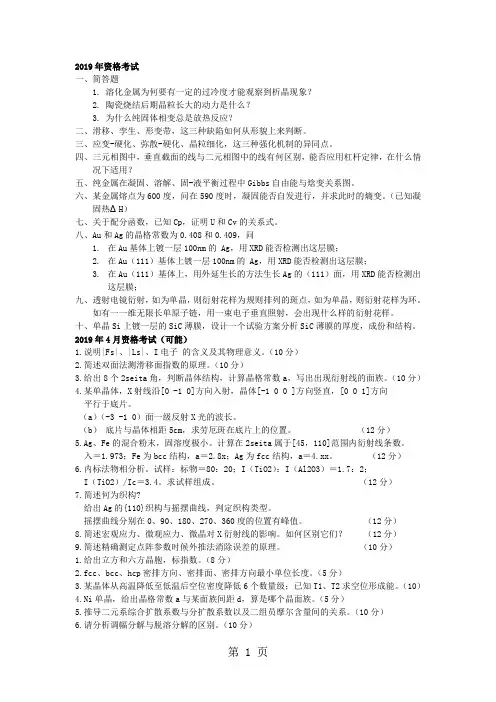
2019年资格考试一、简答题1. 溶化金属为何要有一定的过冷度才能观察到析晶现象?2. 陶瓷烧结后期晶粒长大的动力是什么?3. 为什么纯固体相变总是放热反应?二、滑移、孪生、形变带,这三种缺陷如何从形貌上来判断。
三、应变-硬化、弥散-硬化、晶粒细化,这三种强化机制的异同点。
四、三元相图中,垂直截面的线与二元相图中的线有何区别,能否应用杠杆定律,在什么情况下适用?五、纯金属在凝固、溶解、固-液平衡过程中Gibbs自由能与焓变关系图。
六、某金属熔点为600度,问在590度时,凝固能否自发进行,并求此时的熵变。
(已知凝固热ΔH)七、关于配分函数,已知Cp,证明U和Cv的关系式。
八、Au和Ag的晶格常数为0.408和0.409,问1.在Au基体上镀一层100nm的 Ag,用XRD能否检测出这层膜;2.在Au(111)基体上镀一层100nm的 Ag,用XRD能否检测出这层膜;3.在Au(111)基体上,用外延生长的方法生长Ag的(111)面,用XRD能否检测出这层膜;九、透射电镜衍射,如为单晶,则衍射花样为规则排列的斑点,如为单晶,则衍射花样为环。
如有一一维无限长单原子链,用一束电子垂直照射,会出现什么样的衍射花样。
十、单晶Si上镀一层的SiC薄膜,设计一个试验方案分析SiC薄膜的厚度,成份和结构。
2019年4月资格考试(可能)1.说明|Fs|、|Ls|、I电子的含义及其物理意义。
(10分)2.简述双面法测滑移面指数的原理。
(10分)3.给出8个2seita角,判断晶体结构,计算晶格常数a,写出出现衍射线的面族。
(10分)4.某单晶体,X射线沿[0 -1 0]方向入射,晶体[-1 0 0 ]方向竖直,[0 0 1]方向平行于底片。
(a)(-3 -1 0)面一级反射X光的波长。
(b)底片与晶体相距5cm,求劳厄斑在底片上的位置。
(12分)5.Ag、Fe的混合粉末,固溶度极小。
计算在2seita属于[45,110]范围内衍射线条数。
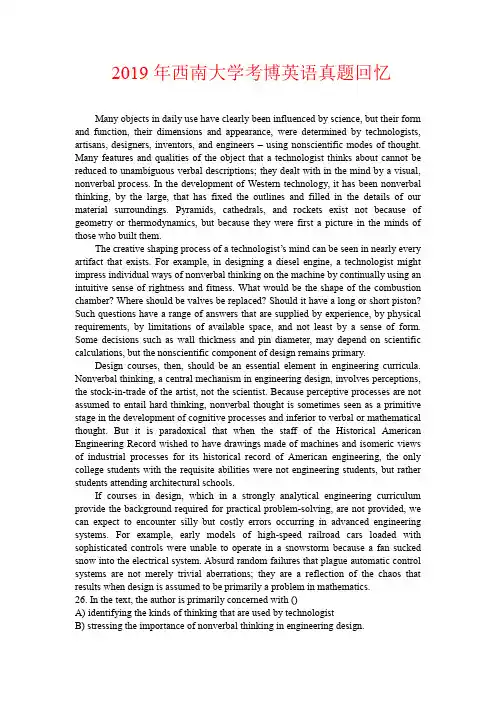
2019年西南大学考博英语真题回忆Many objects in daily use have clearly been influenced by science, but their form and function, their dimensions and appearance, were determined by technologists, artisans, designers, inventors, and engineers – using nonscientific modes of thought. Many features and qualities of the object that a technologist thinks about cannot be reduced to unambiguous verbal descriptions; they dealt with in the mind by a visual, nonverbal process. In the development of Western technology, it has been nonverbal thinking, by the large, that has fixed the outlines and filled in the details of our material surroundings. Pyramids, cathedrals, and rockets exist not because of geometry or thermodynamics, but because they were first a picture in the minds of those who built them.The creative shaping process of a technologist’s mind can be seen in nearly every artifact that exists. For example, in designing a diesel engine, a technologist might impress individual ways of nonverbal thinking on the machine by continually using an intuitive sense of rightness and fitness. What would be the shape of the combustion chamber? Where should be valves be replaced? Should it have a long or short piston? Such questions have a range of answers that are supplied by experience, by physical requirements, by limitations of available space, and not least by a sense of form. Some decisions such as wall thickness and pin diameter, may depend on scientific calculations, but the nonscientific component of design remains primary.Design courses, then, should be an essential element in engineering curricula. Nonverbal thinking, a central mechanism in engineering design, involves perceptions, the stock-in-trade of the artist, not the scientist. Because perceptive processes are not assumed to entail hard thinking, nonverbal thought is sometimes seen as a primitive stage in the development of cognitive processes and inferior to verbal or mathematical thought. But it is paradoxical that when the staff of the Historical American Engineering Record wished to have drawings made of machines and isomeric views of industrial processes for its historical record of American engineering, the only college students with the requisite abilities were not engineering students, but rather students attending architectural schools.If courses in design, which in a strongly analytical engineering curriculum provide the background required for practical problem-solving, are not provided, we can expect to encounter silly but costly errors occurring in advanced engineering systems. For example, early models of high-speed railroad cars loaded with sophisticated controls were unable to operate in a snowstorm because a fan sucked snow into the electrical system. Absurd random failures that plague automatic control systems are not merely trivial aberrations; they are a reflection of the chaos that results when design is assumed to be primarily a problem in mathematics.26. In the text, the author is primarily concerned with ()A) identifying the kinds of thinking that are used by technologistB) stressing the importance of nonverbal thinking in engineering design.C) proposing a new role for nonscientific thinking in engineering design.D) contrasting the goals of engineers with those of technologists.27.It can be inferred that the author thinks engineering curricula are ()A) strengthened when they include courses in design.B) weakened by the substitution of physical science courses for courses designed to developmathematical skills.C)strong because nonverbal thinking is still emphasize by most of the courses.D)strong despite the errors that graduates of such curricula have made in the development of automatic control system.28.which of the following statements best illustrates the main point of the first two paragraphs of the text?()A) When a machine like a rotary engine malfunctions, it is the technologist who is best equipped to repair it.B) Each component of an automobile – for example, the engine or the fuel tank – has a shape that has been scientifically de termined to be best suited to that component’s function.C) A telephone is a complex instrument designed by technologists using only nonverbal thought.D) The distinctive features of a suspension bridge reflect its designer’s conceptualization as well as the physical requirements of its site.29.Which of the following statements would best serve as an introduction to the text?()A) The assumption that the knowledge incorporated in technological developments must be derived from science ignore the many nonscientific decisions made by technologists.B) Analytical thought is no longer a vital component in the success of technological development.C) As knowledge of technology has increased, the tendency has been to lose sight of the important role played by scientific thought in making decisions about form, arrangement, and texture.D)A movement in engineering colleges toward a technician’s degree reflects a demand for graduates who have the nonverbal reasoning ability that was once common among engineers.30.The author calls the predicament faced by the Historic American Engineering Record paradoxical (line 6, paragraph 3) most probably because ()A) the publication needed drawings that its own staff could makeB) architectural schools offered but did not require engineering design courses for their studentC) college students were qualified to make the drawings while practicing engineers were not.D) engineering students were not trained to make the type of drawings needed to record thedevelopment of their own disciplineThe remarkable progress of science and technology in the 20st century has brought enormous benefits to humankind. Long and healthy lives, economic prosperity and a pleasant and convenient living environment have resulted from technological progress based on advances in scientific knowledge. This progress will continue or may even accelerate in the future, because both the number of scientists and their activities are expanding throughout the world. We may expect, therefore, that science and technology will continue to contribute to the development of human society.At the same time, rapid scientific advances may raise some difficult problems. First of all, the disparity in scientific knowledge between those in scientific and technical professions and those in other areas will continuously expand. This may create a communications gap between the two groups that could affect obtaining public consent on important issues, such as the use of genetically engineered plants or human embryonic stem cells. Secondly, the 21st century will be characterized by a knowledge-based society and a knowledge of science will be required for many professions. Those who lack scientific knowledge will have fewer opportunities for good jobs. Thirdly, the enormous increase in scientific information will become a burden for children who must study science. Already young people seem to be losing interest in science, and this trend may increase in the future. Over the past several years, enrollment in high-school physics courses in Japan has been decreasing, which suggests that many young people are losing interest in physics or avoiding subjects that require diligent study. Finally, scientific research in the next century will require increasing levels of public investment because sophisticated research is usually expensive. If the public loses interest in, science or does not understand the importance of research, it will become difficult for scientists to obtain sufficient financial support.Because of these considerations, I think that we need to carefully review present science education at different levels and to improve it in order to meet the expected rapid progress of science in the 21st century. At the level of primary education, the’ most important task is to stimul ate children’s interest in nature. Naive surprise at the wonders of nature will hopefully lead to a later interest in science. During their secondary education, students must learn logic and the principles of natural phenomena. They will gradually separate into groups of those who like and those who dislike science. It will be difficult to provide the latter students with the scientific basics that would be useful throughout their lives. This is also the case in university education.It is becoming a goal of general university education to give students who are not majoring in natural science and engineering some level of scientific literacy. In the future, all citizens, especially those expected to lead diverse areas of society should have a sound basis for understanding the progress of science. Because the pace of progress will accelerate further, continuing science education for the public is also of great importance.1.The first paragraph aims at _____A.Overstating the importance of science and technology.B.Highlighting the crucial role scientists play in the development of science and technology.C.Introducing the problems brought about by rapid scientific advances whiles stating theenormous benefits brought about by the progress of science and technology.D.Predicting the trend of the development of science and technology.2.According to the text, that young people seem to be losing interest in science_____.A.Causes the lack of scientists throughout the world in future.B.Is mainly due to the explosion of scientific information.C.Hinders the development of human society.D.Increases the communications gap between young people and scientists.3.The second paragraph is to denote_____A.The gap between scientific and technical professional and non-professionals.B.The difficulties faced by young people in finding jobs.C.The difficulties problems raised by rapid scientific advances.D.Scientific research in the 21th century.4.To which of the following statements is the author most unlikely to agree?A.It is a sheer waste of time and money to force those who dislike science to learn science.B.Stimulating children’s interest in nature is the top priority for primary and secondaryschool authorities.C.Secondary school students should learn logic and the principles of natural phenomena.D. A knowledge of science will be required for many professional in the 21st century5.The best title for this text might be_____A.Science education for the publicB.Science and technology in the 21st centuryC.Scientific advance and ensuing problemsD.The goal of primary, second and higher education还有一篇阅读是讲迈克杰克逊的歌曲,专辑。